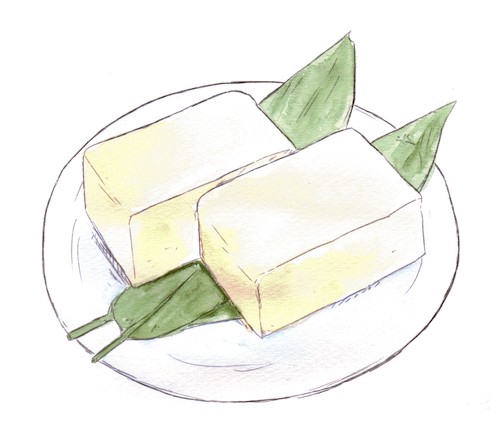
Illustrations by Kaki Okumura
Tofu isn’t a meat replacement, even in this Japanese version of a burger
I meet a lot of people who aren’t the biggest fans of tofu, even when they want to add it into their diet. Tofu is high in protein and low in calories and fat, and much more environmentally friendly than proteins like beef or chicken. But it seems that a lot of people have a hard time getting over the taste — they describe it as bland, spongy, and the rawness of the soy flavor as not very appetizing.
This confused me at first, but now it’s easy to see why. Western cultures have championed tofu as the optimal protein alternative for vegans and vegetarians, something to replace meat. Especially for firm tofu, this branding makes tofu seem like meat’s less flavorful, squishier, “healthy” alternative. Tofu teriyaki bowls and BBQ tofu stir-frys don’t quite ring as appetizing as meat, and many of these recipes end up adding lots of sugar, salt, and oil to replace the flavor that would be in animal-based proteins. Many people are unyielding in their conclusion: Tofu isn’t worth it!
But the Japanese use of tofu has never been as a replacement for meat, but rather a standalone ingredient. This is an important difference in point of view for those of us who enjoy meat because cooking with tofu should be about complementing meals, not replacing the foods we enjoy. In fact, properly prepared, our favorite foods can actually taste better with a bit of tofu — it’s soft, absorbs spices really well, can char nicely, and adds a light and refreshing element to heavier, oily foods.
In fact, properly prepared, our favorite foods can actually taste better with a bit of tofu — it’s soft, absorbs spices really well, can char nicely, and adds a light and refreshing element to heavier, oily foods.
So if you like meat, but want to reduce its intake and incorporate some more tofu in your life — whether for health reasons or environmental — here’s an introduction to Japanese cooking with tofu.
Beginner cooking with tofu
There are many kinds of tofu, but in general, they come in two types: silky and firm. Make sure to buy firm or extra firm tofu for this recipe.
Also, the biggest mistake that most people make when cooking with tofu is that they don’t remove the water. Tofu contains a lot of water, and so it’s important to press it to let the tofu taste less like a soy-like watery mess and more like something with a proper bite. You could put tofu on a cutting board and press it under books for 30 minutes, or you can take my shortcut using a microwave:
- Wrap the tofu in two sheets of paper towels.
- Place it on a glass plate, and microwave for about 2–3 minutes.
Pressing allows for more control and helps release more water, but I have found the microwave to work just fine.
Japanese Wafū Hambagu
Makes: 4 servings
Wafū hambagu is a Japanese take on the traditional burger. Much lighter in taste and flavor, it is a great balance of sweet, salty, and a bit tangy. The tofu is a great addition because it’s soft and absorbs the flavor of the sauce well, and keeps the dish light and refreshing — not too heavy. While it’s not a replacement for an American burger, it’s brilliant and delicious in its own right.
Ingredients
- 150g minced meat (chicken, pork, or beef)
- 300g firm tofu
- 1 onion, minced
- 5g dried hijiki (optional)
- 2 tablespoons flour
- Salt and pepper to taste
- 3 tablespoons ponzu
- 1 tablespoons each sugar, sake, soy sauce, and mirin
- 1 pack shiso leaves
- 400g grated daikon (about ¼ of a whole daikon)
Instructions
- Press the tofu, rehydrate the hijiki, mince the onion, and grate the daikon.
- Once ready, mix the minced meat, tofu, onion, hijiki, flour, salt, and pepper together in a large bowl.
- Mold into patties, and cook on medium heat until it browns, flip, and then put a lid on it to let it steam for another 4–5 minutes.
- Remove the patties from the pan and put aside, and add ponzu, sugar, sake, soy sauce, and mirin, and simmer on low. Once it reduces a bit, turn off the heat and put the burgers back in the pan to lightly cover in the sauce.
- Plate the burgers, top with shiso and grated daikon. Enjoy!

Why I love cooking with tofu
Consuming more tofu doesn’t necessarily mean having to eliminate meat. Instead, it can just be about making dishes that actually taste better with a bit of tofu and a little less meat. In this way, we end up with dishes that contain more nutrient-dense, plant-based foods that actually taste better, are better for our bodies, and as an added bonus are a bit better for the environment.
So if you enjoy meat, consider tofu as an ingredient, not a replacement. Because the better and more sustainable way to focus on healthy eating is not being worried about eliminating the foods we love, but discovering ways to add ingredients that are good for us to complement the foods we enjoy.


If you enjoyed this piece or want to learn more about healthy Japanese lifestyle principles, email me at kokumura@kakikata.space! I would love to hear from you 😊
Warm regards,
Kaki